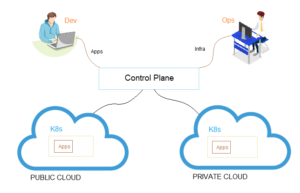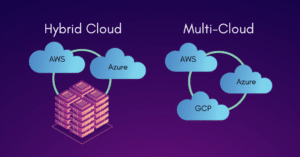IMPORTANCE OF MULTICLOUD
MULTICLOUD
MultiCloud is a cloud computing approach which uses two or more cloud environments. It uses multiple cloud computing and storage services in a heterogeneous architecture. The cloud assets, software, applications etc. are distributed across several cloud hosting environments like AWS, Azure, Google, etc. The distribution can be, by using different cloud providers for different workloads or by distributing a single workload across multiple providers, etc. MultiCloud benefits customers by eliminating the risks of single point of reliance and dependency on one provider. It provides flexibility and may also help to reduce cost by selecting a competitive provider based on the services. In some cases, local or regulatory compliances would require you to choose different providers in different geographical regions. Though MultiCloud architecture offers a lot of benefits, managing a MultiCloud environment and its security are relatively complex and requires more efforts and greater expertise.
MULTICLOUD VS HYBRID CLOUD
Both refer to cloud deployments that integrate more than one cloud, but not the same. In hybrid cloud you work with multiple public cloud environments with an objective to achieve interoperability and portability. But in MultiCloud you build your cloud infrastructure on more than one public cloud providers with or without a private cloud.
Fig: MultiCloud Vs HybridCloud
Hybrid Cloud integrates public cloud with a private cloud or on-premises infrastructure. This happens when some businesses migrate partly to the cloud and keep some process, logic and data still in legacy on-premise systems and infrastructure.
MultiCloud refers to the combination and integration of multiple public clouds. If a MultiCloud deployment includes private cloud or on-premise cloud as well, then it could be considered as Hybrid Cloud. Alternately, if a Hybrid Cloud deployment incorporates multiple public clouds, then it can also be considered as a MultiCloud.
WHY YOU NEED MULTICLOUD?
Scalability: First and foremost reason for any enterprise to decide to move to cloud from an on premise infrastructure will be the need for scaling. As the business grows, one needs more reliable, available and secure environment for hosting applications and data.
Availability: If you want to achieve the five nine (99.999) availability target, MultiCloud is the way to go. If something goes wrong in one cloud, you have the other one up and running to ensure availability.
Better User Experience: While you have users across the globe and they are served from multiple cloud platforms (say closer to their geographic location), users get lower latency and better user experience.
Integrations: If you have specific integrations that work with specific clouds, MultiCloud is the best fit. This allows one to keep sensitive private data in on-premise data center or private cloud if required and still have the option to integrate with services running in public clouds.
Regulatory: Based on regulatory policies, some countries/organizations do not allow you to take out or store sensitive data out of their region. In these cases, MultiCloud strategy can enable services to the customers in these regions while meeting local regulatory compliances.
MULTICLOUD STRATEGIES
The following are the pillars of a successful MultiCloud strategy,
Automation: is the key. Both operations (OPS) and development (DEV) processes need to be fully automated. OPS manage the infrastructure, creating clusters, setting up network, etc., while DEVs build applications, containerize it and want to deploy it to the infrastructure created by OPS. An intermediary layer called control plane is used to coordinate and manage these two activities. OPS push the configurations to the control plane and the control plane creates and manages the clusters in different cloud environments. DEVS push the builds to the control plane and it in turn deploys the apps to the respective clusters.

Fig: Role of Control Plane
Manual intervention can be error prone and can also be a security risk. Anything related to security on the cloud, it is the best to leverage automation than using time consuming and error prone manual intervention to setup, run, monitor or respond to events. So adopting automation is the first step in achieving MultiCloud security.
Visibility: Visibility is very important to work with multiple teams and multiple clouds. A unified dashboard which shows audit trails of all builds, deployments, cluster status, resource utilization, etc., across multiple clouds is a must. Use of MultiCloud platforms increased the visibility challenge. While moving to a MultiCloud architecture, usual monitoring mechanisms won’t be enough to monitor the entire environment. It is important to have auditability, visibility, alerts and monitoring be in built in to your MultiCloud solutions to improve security.
Governance: Regulatory and compliance policies varies from region to region. OPS should be able to push the respective policies to the affected regions just in one touch. A unified control plane helps in simplifying this process too.
Security: Though MultiCloud provides the benefits of flexibility, scalability and elasticity, it presents significant security challenges while consuming resources from multiple clouds. Ensure proper configuration management, security policies, automation, dashboards and auditability to achieve better security.
Configurations: While making tons of continuous changes every day, any misconfiguration need to be detected and corrected immediately. Ensure that you have the right configuration compliance. Even a single small misconfiguration can lead to security breaches.
Orchestration: Adopting to the new method of operating in a MultiCloud environment could be challenging. It is becoming hard to find suitable trained and skilled resources to manage MultiCloud environments. In this scenario, it becomes extremely important to develop and implement proper MultiCloud orchestration and automation for reducing security risks and enforcing compliance.
DevOps Processes: It is critical to have well designed DevOps (CI/CD) pipeline for a successful and secure MultiCloud strategy. A more traditional, manual process of DevOps is not going to work in MultiCloud environments and has inherent risks. Make sure the tools selected for MultiCloud management have automated DevOps processes in built.
PLANNING CONSIDERATIONS
Though MultiCloud sounds like a perfect solution, there are few potential issues that may pop up when integrating with multiple cloud providers.
Complexity: Cloud itself is complex and hard to setup. MultiCloud adds more complexity and it takes a lot of time and effort to set it right. Steep learning curve is involved to configure and to manage MultiCloud resources, which can be challenging.
Lack of Resources: Skilled experienced professionals proficient with multiple cloud technologies and expertise are very few. It is hard to find skilled developers, security engineers, etc. to configure and manage MultiCloud platforms.
Cost Planning: Distributing workloads across different cloud providers can be cost effective. But understanding the different pricing structure, tracking the expenses and monitoring can be challenging as the prices keep varying.
User Errors: According to Gartner, the reasons for most of the security failures in cloud environments are due to the lack of knowledge and the user errors during configuration of the environment. In a Multi-Cloud environment, large number of configuration options to setup, can increase the likelihood of user errors.
Right Tools: Choosing the right tools can make MultiCloud management effective. Having wide range of tools available in the market from different providers, it can be difficult to choose the right one meeting the organizational requirements.
Security: Implementation in MulitCloud is not done correctly, there can be more chances for security issues. It will be hard to synchronize security policies across vendors, to provide required visibility, and monitoring capabilities in a MultiCloud environment.
SUMMARY
A rightly implemented MultiCloud environment will provide many advantages to a growing enterprise, like flexibility, scalability, elasticity, availability, better user experience, high levels of security and compliance. Selection of good MultiCloud tools with built in features to support the architecture is the key to a successful MultiCloud implementation.
Find below some of the best practices that may help to improve security of multi-cloud deployments significantly.
• Synchronize policies and settings across operators
• Use different individual security policies for different workloads
• Automate to reduce the human errors and the associated risks
• Choose the right tools for MultiCloud management
• Use dashboards & monitoring to review logs, performance and generate alerts
• Maintain compliance across different platforms using best available tools
• Integrate with a single point of control plane to manage platforms, application and data
• Minimise security solutions what do not integrate well
About The Author

Dr. Anil Kumar
VP Engineering
Founder | Architect | Consultant | Mentor | Advisor | Faculty
Solution Architect & IT Consultant with more than 25 yrs of IT Experience. Served in various roles, with both national and international institutions. Expertise in working with both legacy and advanced technology stacks and business domains.


